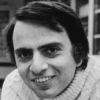Carl Sagan

Carl Sagan
Carl Edward Saganwas an American astronomer, cosmologist, astrophysicist, astrobiologist, author, science popularizer, and science communicator in astronomy and other natural sciences. He is best known for his contributions to the scientific research of extraterrestrial life, including experimental demonstration of the production of amino acids from basic chemicals by radiation. Sagan assembled the first physical messages sent into space: the Pioneer plaque and the Voyager Golden Record, universal messages that could potentially be understood by any extraterrestrial intelligence that might find...
NationalityAmerican
ProfessionScientist
Date of Birth9 November 1934
CityBrooklyn, NY
CountryUnited States of America